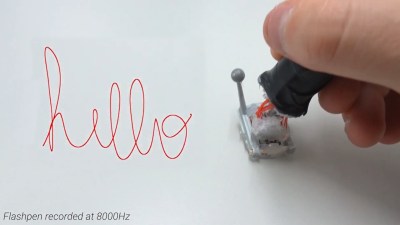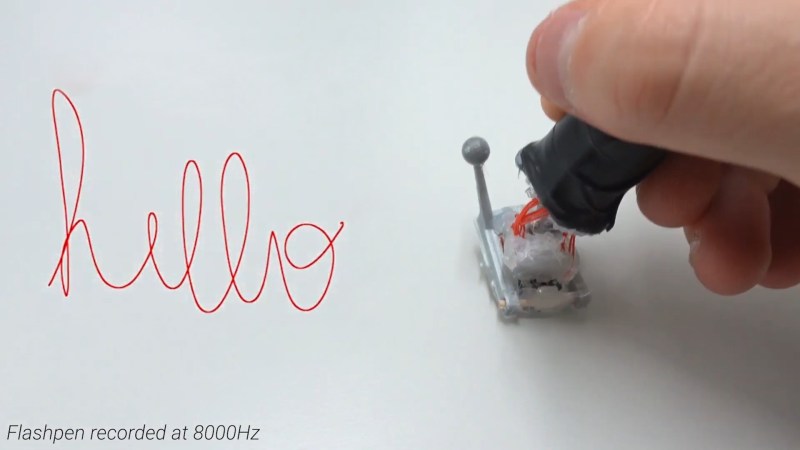Pen input has never really taken off in the computing mainstream, though it’s had somewhat of a renaissance in the last decade or so. Various smartphones and tablets are shipping with the technology, and some diehard users swear by it as the best way to take notes on the go. Recently, researchers at the Sensing, Interaction and Perception Lab at ETH Zurich have been working on Flashpen, a high-fidelity pen interface for a wide range of applications.
 The fundamental technology behind the pen is simple, with the device using an optical flow sensor harvested from a high-end gaming mouse. This is a device that uses an image sensor to detect the motion of the sensor itself across a surface. Working at an update rate of 8 KHz, it eclipses other devices in the market from manufacturers such as Wacom that typically operate at rates closer to 200Hz. The optical sensor is mounted to a plastic joint that allows the user to hold the pen at a natural angle while keeping the sensor parallel to the writing surface. There’s also a reflective sensor on the pen tip which allows cameras to track its position in space, for use in combination with VR technology.
The fundamental technology behind the pen is simple, with the device using an optical flow sensor harvested from a high-end gaming mouse. This is a device that uses an image sensor to detect the motion of the sensor itself across a surface. Working at an update rate of 8 KHz, it eclipses other devices in the market from manufacturers such as Wacom that typically operate at rates closer to 200Hz. The optical sensor is mounted to a plastic joint that allows the user to hold the pen at a natural angle while keeping the sensor parallel to the writing surface. There’s also a reflective sensor on the pen tip which allows cameras to track its position in space, for use in combination with VR technology.
The team show off the device being used in several ways, primarily in VR tasks, but also in simple handwriting and coloring work. It’s a project that could readily be replicated by any eager experimenter by gutting a gaming mouse and getting down to work; our writers will expect six of your submissions by June 1st to the tipsline. Those eager to learn more can check out the project paper, and may also find the team’s TapID technology interesting. Video after the break.

















” It’s a project that could readily be replicated by any eager experimenter by gutting a gaming mouse and getting down to work; our writers will expect six of your submissions by June 1st to the tipsline. ”
Make sure it’s a cheap mouse. Those good mice with the nice sensors can cost.
So, it’s an optical mouse on a wobbly stick, with a pair of vr tracking balls. Hardware wise pretty easy to make at home. It’s going to be advances in the software, where this thing could really shine, going forward, but time will tell, if it becomes popular.
Games development and graphic design perhaps.
It sort of reminds me of an old parallel port text scanner “data pen” I used to have many years ago. Pretty advanced for the time when it was released.
I wonder if the tip could be a small lens (say, harvested from a cell phone camera), to refocus the image like a periscope onto the sensor sitting higher into the body.
I think you’re onto something there. If they could get the tip, to be more of a tip than an optical mouse sensor lens assembly that would be a big step up in functionality.
Fiber optics + laser + optical divider to get reflected light onto the sensor + ruby sphere on the tip.
Maybe a round fish eye lens and some software to determine where the tip is contacting the paper?
Livescribe from 2007 or maybe Mobile Digital Scribe by IOGEAR
If they keep at it they may come up with other next gen stuff like being able to hover, pressure sensitivity, tilt angle detection. They just need to gut a graphic tablet.
A system honed through millennia of linguistic and alphabetic evolution is usually pretty good
Wacom doesn’t need to be 8kHz, as it’s absolutely positioned on every reading, it’s not working on tracking movement like a mouse.